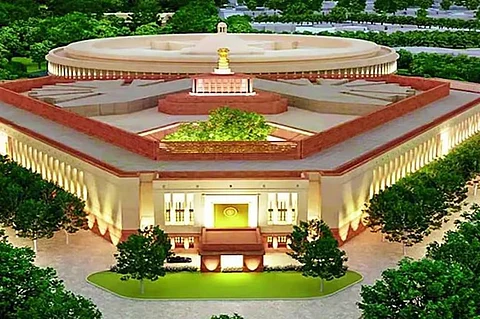

Between 2014-15 and 2023-24, a total of 1,73,396.87 hectares of forest land has been approved for various non-forestry purposes, including infrastructure projects, under the provisions of the Van (Sanrakshan Evam Samvardhan) Adhiniyam, 1980, Bhupender Yadav, Union Minister for Environment, Forest and Climate Change, told the Lok Sabha.
There is adequate availability of power in the country, Union Minister of State for Power Shripad Naik told the Rajya Sabha.
The current installed generation capacity stands at 470 gigawatt (GW). The Government of India has addressed the critical issue of power deficiency by adding 238 GW of generation capacity since April 2014, transforming the country from being power-deficient to power-sufficient, the minister stated.
Additionally, since 2014, 201,088 circuit kilometres of transmission lines, 778,017 megavolt-amperes of transformation capacity and 82,790 megawatts (MW) of inter-regional capacity have been added, enabling the transfer of 118,740 MW of power across the country, Naik said.
As of February 28, 2025, the country's electricity generation capacity from non-fossil fuel sources was approximately 223 GW, including around 215 GW of renewable energy (RE) capacity, Naik told the Rajya Sabha. During the current financial year, around 24 GW of RE capacity has been added so far.
Since 2014-15, the Ethanol Blending in Petrol programme has facilitated expedited payments of over Rs 1,04,000 crore to farmers up to January 2025, Union Minister of State for Petroleum & Natural Gas Suresh Gopi told the Rajya Sabha.
Additionally, it has resulted in estimated foreign exchange savings of over Rs 1,20,000 crore, net carbon dioxide reduction of approximately 62.6 million metric tonnes and crude oil substitution exceeding 20 million metric tonnes, he stated.
The National Policy on Biofuels promotes and encourages the use of various feedstocks, including maize, sugarcane juice, molasses, damaged food grains such as broken rice and agricultural residues (e.g. rice straw, cotton stalks, corn cobs, sawdust and bagasse), Gopi said.
The extent of feedstock utilisation for ethanol production varies annually, depending on factors such as availability, cost, economic feasibility, market demand and policy incentives. Any diversion of sugarcane juice, its by-products, or maize for ethanol production is carefully calibrated in consultation with relevant stakeholders, the minister stated.
According to the Roadmap for Ethanol Blending in India 2020-25, prepared by an inter-ministerial committee, the use of 20 per cent ethanol-blended petrol (E20) results in a marginal reduction in fuel efficiency for four-wheelers originally designed for E10 but calibrated for E20, Gopi told the Rajya Sabha.
The Society of Indian Automobile Manufacturers (SIAM) informed the committee that modifications to engine hardware and tuning can minimise efficiency losses due to blended fuel. The report also highlighted that no significant issues were observed in vehicle performance, engine component wear, or engine oil deterioration when using E20 fuel, Gopi stated.
An analysis of the frequency of extremely heavy rainfall events from 2019 to 2024 shows that Karnataka recorded the highest number of such occurrences in 2019, with 59 instances reported at various stations across the state, followed by 38 in 2020 and 30 in 2024, V Somanna, Union Minister of State for Jal Shakti, told the Rajya Sabha.
The state government assesses damages caused by 12 notified natural calamities, including heavy rainfall and floods and provides relief assistance from the State Disaster Response Fund (SDRF), which is allocated as per Government of India norms. Additional financial assistance is provided from the National Disaster Response Fund (NDRF) in cases of disasters classified as ‘severe’, based on assessments conducted by an Inter-Ministerial Central Team, Somanna stated.
For Karnataka, during the 2024-25 financial year (as of 12 March 2025), Rs 976 crore has been allocated under the SDRF, with Rs 366 crore and Rs 3,454.22 crore released under the SDRF and NDRF, respectively, the minister said.
Between 2020 and 2024, the country’s annual groundwater recharge increased from 436.15 billion cubic metres (BCM) to 446.90 BCM, while total annual groundwater extraction for all purposes remained stable, rising marginally from 244.92 BCM to 245.64 BCM, Union Minister of State for Jal Shakti Raj Bhushan Choudhary told the Rajya Sabha.
Additionally, the Stage of Groundwater Extraction (SoE), which represents the ratio of total annual extractable groundwater to total annual groundwater extraction, declined from 61.6 per cent to 60.47 per cent, indicating an overall improvement in the groundwater scenario, the minister said.
As part of the Swachh Bharat Mission (Grameen), 253,000 community sanitary complexes and 118.3 million individual household latrines have been constructed to date, Somanna told the Rajya Sabha. A total of 5,64,157 villages have declared themselves open defecation free plus, classified as ‘aspiring’ (1,11,657), ‘rising’ (7,337) and ‘model’ (4,45,163) as of March 20, 2025.
Under the National Mission for Clean Ganga, from January to December 2024, a total of 27 projects were completed, bringing the cumulative total to 305, Choudhary told the Rajya Sabha.
Additionally, 39 new projects were sanctioned in 2024 at a cost of Rs 2,056 crore. To support pollution abatement, 12 sewage treatment projects with a capacity of 203.55 million litres per day (MLD) were approved in 2024, bringing the cumulative total to 206 sewage treatment projects with a capacity of 6,335 MLD since the launch of the Namami Gange programme, the minister said.